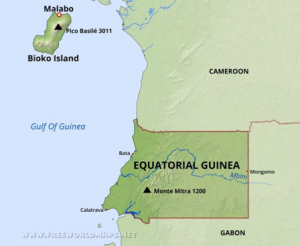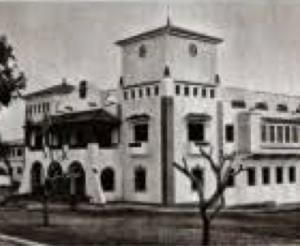by Mark L. Asquino
Introduction
Almost fifty years have passed since the terrible day in 1971 when one State Department officer brutally killed another in the tiny, African country of Equatorial Guinea. What took place there is a lurid story of sex, madness and murder that almost every foreign service officer has heard about at one time or another. In many ways it’s the State Department’s version of the 1984 classic film, “Nightmare on Elm Street.” However, the murder in Equatorial Guinea is a real-life tale of horror that continues to intrigue foreign service officers. Here are the basic facts of what happened.
On August 30, 1971, Alfred Erdos, the principal officer at the U.S. Embassy in Equatorial Guinea (EG), stabbed to death his administrative assistant, Donald Leahy. Based on a U.S. autopsy of Leahy’s body, prosecutors alleged the men were having a homosexual affair. The murder weapon was a pair of standard-issue, U.S. government scissors. The crime occurred inside the embassy, and Leahy’s body was later found in an unused office. On the day of the murder, Erdos made wild accusations over the embassy radio about a Soviet invasion of the country. Len Shurtleff, serving at the nearby U.S. consulate in Douala, Cameroon was asked by Lannon Walker, the acting chief of mission at the U.S. Embassy in Yaoundé, to investigate the bizarre broadcast. Shurtleff immediately took a charter flight to Equatorial Guinea where he discovered the grisly crime.[i]
I first heard a version of the infamous Erdos-Leahy murder story during my entry-level officer training in the fall of 1978. By then, it had already become a foreign service urban legend. Little did I know that someday I’d serve as U.S. ambassador to Equatorial Guinea.
But while the story has been retold and embellished in the process, few know the background leading up to the actual crime. By the time of my 2012 assignment to Malabo, articles had been published by those who witnessed the aftermath of the crime. I delved into these accounts as well as read numerous books about EG’s sad, turbulent history. And then I lived in the country for three years and saw the house where the murder took place. All have provided me with the following insights on that tragic day in 1971.
Spain’s Only Former Colony in Sub-Saharan Africa

Equatorial Guinea, which had been a Spanish colony since 1778, became an independent nation on October 12, 1968. The capital, then called Santa Isabel and later Malabo, was on the small island of Fernando Po, which would be renamed Bioko. A larger part of Equatorial Guinea is on Africa’s mainland and shares borders with Cameroon and Gabon. With a land mass the size of Maryland, EG in 1971 had a population of about 300,000 people, making it one of Africa’s smallest countries.
Francisco Macias, a minor bureaucrat in the Spanish colonial administration, was
elected through UN supervised polling in 1968 as independent EG’s first president. Once in power, Macias unleashed a reign of terror on his people. By 1970, Washington had no illusions about Macias. He was described in cables as erratic, vindictive, and most likely mentally disturbed. But despite these assessments, the U.S. continued to maintain its relationship with the Macias regime to counter-balance the spread of communism in Africa.
Rather than assign a resident ambassador to Santa Isabel, the U.S., starting in 1969, sent principal officers to its small embassy there. The latter reported to ambassadors in neighboring countries, who were accredited as non-resident chiefs of mission to EG. The U.S. Embassy in Santa Isabel reported to Lewis Hoffacker, ambassador to Cameroon, who was looking for someone in 1971 to assume the difficult EG assignment. By then there were reports that the screams of political prisoners being tortured to death at one of Macias’ detention centers across the street from the U.S. principal officer’s residence could be heard day and night. Western diplomats, confined to the island of Fernando Po, were not allowed to leave the capital without permission.
When State approached Alfred Erdos about the job, he had been in the foreign service for twenty years. Hoffacker knew Erdos casually, and had a generally good impression of him. Recent supervisors had used adjectives that included “cool,” “capable’ and “unflappable” to describe Erdos. Based on this, Hoffacker approved the assignment. But as he discovered after the murder, Erdos had the reputation as a strict disciplinarian who bullied and mistreated subordinates at his previous post.
Erdos arrived in the capital of Santa Isabel in April 1971, accompanied by his wife and two-year old son. The only other American assigned to the embassy was administrative assistant Donald Leahy who was with his Ecuadoran wife.
Erdos wrote in a mid-August note to Hoffacker that Leahy “…is a nice guy but is way over his head…He should be in a job where various supervisors can tell him what to do.” In the same note, Erdos asked that Leahy be transferred, indicating conflict was brewing between them: “…lately (Leahy) blows up at any implied criticism of his work.”[ii]
The Russians Are Coming!
Erdos’ supervisor, Lannon Walker, found something “non- professional” about his reporting on EG’s political and economic developments.[iii] Beginning on August 20, Erdos’ messages became increasingly alarmist. He claimed EG was veering out of control, and that its government had turned against him.[iv]
On August 30, Erdos prepared a cable claiming there was a Soviet plot being orchestrated in EG against the U.S., and asserted he’d been targeted for death. The plotters included the embassy’s locally employed staff and Dan Leahy. When Leahy refused to encrypt and send the message, Erdos forced him into the communications vault. He then made his assistant sit in a chair, bound him with electrical cord, and interrogated him.
Erdos was convinced of Leahy’s role in the Soviet conspiracy, and in a call for help via the vault’s radio said:
“I am not losing my mind. I am locked in the vault with my admin officer who is a communist agent and part of a massive plot against the United States. The U.S. will be accused shortly in a large showing at the UN and I fear for my life. I feel assured that if I leave the vault I will be killed. We have been misdirected and all or any reports from here are not to be believed.
All local employees are part of the plot and have placed electronic devices in the homes. I am extremely worried about my wife and son who are alone at home… I am in complete control of my faculties. And I realize how dramatic this sounds but this is the way things are. Please rush help immediately.”[v]
Listening to the unhinged broadcast in Yaoundé, Lannon Walker, as noted above, asked Douala consul Len Shurtleff to fly immediately to Santa Isabel to investigate what was happening.
“I lost my cool. I killed Don.”
At some point, Leahy was able to free himself, but as he tried to leave the vault, Erdos stabbed him with a pair of scissors. Nevertheless, Leahy escaped and ran to the embassy’s main door. But Erdos caught up with him, stabbing him repeatedly. One of the blows nicked Leahy’s jugular vein, causing him to bleed to death. Erdos then dragged his subordinate’s lifeless body to a nearby, empty office.

When Douala consular officer Shurtleff arrived at the embassy in Santa Isabel during the early evening of that same day, Erdos refused to let him enter the building. But Erdos later talked to his wife and allowed her inside the embassy. When he finally came out, Erdos said to Shurtleff,
“I lost my cool. I killed Don.”
After being taken to Cameroon by Hoffacker, Williams and Shurtleff, Erdos was flown to Washington on an official U.S. aircraft in the custody of an embassy security officer. Leahy’s body was transported on a separate plane. Erdos was served with a criminal summons upon arrival at Dulles Airport, and immediately taken to George Washington University Hospital for psychiatric observation. He was subsequently released on bond after being formally indicted for first degree murder. He pled not guilty, with his attorneys mounting an insanity defense.[vi] The prosecution later reduced the charge to second degree murder.
Homosexual Hysteria or Temporary Insanity?
A U.S. autopsy of Leahy’s body revealed intact spermatozoa in his pharynx and esophagus. During his February 1972 trial, Erdos denied ever having had sexual relations with Leahy. Although the forensic evidence pointed to a homosexual act having occurred in the vault, DNA analysis had yet to be developed. This precluded definitive linking of the spermatozoa to Erdos. The two George Washington University Hospital psychiatrists testified that he had suffered an episode of acute paranoid psychosis. Erdos, they argued, had been delusional and not criminally culpable for the August 30 crime. In their view, any homosexual act that might have occurred in the vault resulted from Erdos’ disturbed state of mind. Personally, I find the psychiatrists’ analysis quite compelling.
However, prosecutors labeled the crime “a homosexual murder,” arguing there had been a violent, romantic falling out between the two men. This led Erdos to murder Leahy in an act of homosexual hysteria. Erdos, said prosecutors, had feigned mental illness, concocting a Soviet invasion plot that he wrote about in a cable and spoke of in the radio broadcast. Both acts were carried out to provide Erdos with a “temporary insanity” motive for killing Leahy.
On March 4, 1972, the jury returned a verdict of voluntary manslaughter against Erdos. While jurors rejected Erdos’ defense team’s argument that he was innocent by reason of temporary insanity, they also declined to convict him of second-degree murder. Erdos received the maximum sentence of ten years in prison. An appeal of the verdict was rejected by the Fourth District Court in Richmond. Erdos was released on parole in 1976 after serving a little over three years. He reportedly never expressed remorse for murdering Leahy, and in 1983 died of a heart attack in California.[vii]
As indicated previously, forensic evidence from Leahy’s autopsy points to his having performed oral sex on Erdos. To this day, that remains the most titillating aspect of the murder. But exactly why the sexual act occurred will never be known. It is something Erdos took with him to the grave. In my view, it was most likely an involuntary act demanded by a delusional Erdos and performed by Leahy in a desperate attempt to save his life.[viii]
Conclusion
A great deal has changed in Equatorial Guinea since 1971. With the discovery of oil and gas in the mid-1990’s, the country now has enormous wealth, although only the ruling elite benefits from it. While still a brutal dictatorship ruled by Macias’ nephew, Teodoro Obiang Nguema, who overthrew his uncle in 1979, even EG’s beleaguered opposition would grudgingly admit life has improved somewhat since then.
It’s been decades since the building where the murder occurred served as our embassy. We now have a modern diplomatic compound that I was honored to inaugurate in 2013. But despite all of this, any time I tell diplomatic colleagues I served as ambassador to Equatorial Guinea, they look at me rather strangely. I imagine they are thinking: “Who would want to be ambassador in that god-forsaken place?!” I certainly understand their reaction, but for me the assignment was the capstone of my diplomatic career and remains a fascinating chapter in my life.
Let me conclude with a personal anecdote. One day toward the end of my time in Equatorial Guinea, I asked my driver, who was steeped in local history, to show me where the Erdos-Leahy murder had taken place. We drove near Malabo’s shoreline, the car stopped, and the driver pointed to a private residence in the distance where our embassy had been in 1971. I opened the vehicle’s heavy, armored door, stepped out and looked at the house for what seemed like a long time. And I will admit that despite the relentless, tropical heat, I felt a sudden chill as I recalled the phrase,
“I lost my cool. I killed Don.”![]()
Notes
[i] See Len Shurtleff, “A Foreign Service Murder,” Foreign Service Journal, October 2007 (https://www.afsa.org/sites/defaul/files/october2007fsj.pdf and the article by Alfred Erdos’ son, Chris Erdos, “Heart of Darkness,” Foreign Service Journal, April 2008 (https://www.afsa.org/sites/defaul/files/april2008fsj.pdf) for contrasting accounts of the crime.
[ii] Lewis Hoffacker, “Murder in an Embassy, Part 1 – ‘I am not losing my mind,”, p.4. Association for Diplomatic Studies and Training (https://adst.org/2013/9) Accessed on July 18, 2019.
[iii] Asquino-Walker telephone conversation, July 22, 2019. I am deeply indebted to Ambassador Lannon Walker for this and other insights he provided me about the Erdos-Leahy episode.
[iv] Hoffacker, “Murder in an Embassy, Part I”, p. 5.
[v] Quoted from Huffaker, “Murder in an Embassy, Part I.” p. 7.
[vi] Lewis Hoffacker, “Murder in an Embassy, Part II -Paranoid Psychotic or Faked Insanity?” p. 1-2 Association for Diplomatic Studies and Training, (https://adst.org/2013/09) Accessed on July 25, 2019
[vii] Shurtleff, p. 54.
[viii] In retired foreign service officer Bill Lenderking’s self-published novel based on the crime, he has a character say that the sex act was not committed for sexual gratification, but rather to dominate, control and humiliate the victim. This seems to me a persuasive, albeit unprovable, theory. See Bill Lenderking, The Soul Murderer: A Psychological Mystery, (2013) p. 433.

Mark Asquino served as U.S. ambassador to Equatorial Guinea during 2012-2015. He is working on a memoir focused on his time there. After a 37 year foreign service career with USIA and State that included postings in Latin America, Europe, Central Asia and Africa, Mark and his wife Jane retired to Santa Fe, New Mexico in 2016.
